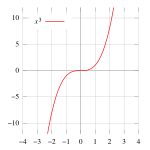Inflection point
This article includes a list of general references, but it lacks sufficient corresponding inline citations. (July 2013) |


In differential calculus, an inflection point, point of inflection, flex, or inflection (inflexion) is a point on a curve at which the curvature or concavity changes sign from plus to minus or from minus to plus. The curve changes from being concave upwards (positive curvature) to concave downwards (negative curvature), or vice versa.[1]
A point where the curvature vanishes but does not change sign is sometimes called a point of undulation or undulation point.
In algebraic geometry an inflection point is defined slightly more generally, as a point where the tangent meets the curve to order at least 3, and an undulation point or hyperflex is defined as a point where the tangent meets the curve to order at least 4.
Equivalent forms
The following are all equivalent to the above definition:
- a point on a curve at which the second derivative changes sign. This is very similar to the previous definition, since the sign of the curvature is always the same as the sign of the second derivative, but note that the curvature is not the same as the second derivative.[1]
- a point (x, y) on a function, f(x), at which the first derivative, f′(x), is at an extremum, i.e. a (local) minimum or maximum. (This is not the same as saying that y is at an extremum).
- a point p on a curve at which the tangent crosses the curve at that point. For an algebraic curve, this means a non singular point where the multiplicity of the intersection at p of the tangent line and the curve is odd and greater than 2.[2]

A necessary but not sufficient condition
If x is an inflection point for f then the second derivative, f″(x), is equal to zero if it exists, but this condition does not provide a sufficient definition of a point of inflection. One also needs the lowest-order (above the second) non-zero derivative to be of odd order (third, fifth, etc.). If the lowest-order non-zero derivative is of even order, the point is not a point of inflection, but an undulation point. However, in algebraic geometry, both inflection points and undulation points are usually called inflection points. An example of such an undulation point is y = x4 for x=0.
It follows from the definition that the sign of f′(x) on either side of the point (x,y) must be the same. If this is positive, the point is a rising point of inflection; if it is negative, the point is a falling point of inflection.
Categorization of points of inflection
Points of inflection can also be categorized according to whether f′(x) is zero or not zero.
- if f′(x) is zero, the point is a stationary point of inflection, also known as a saddle-point
- if f′(x) is not zero, the point is a non-stationary point of inflection

An example of a saddle point is the point (0,0) on the graph y = x3. The tangent is the x-axis, which cuts the graph at this point.
A non-stationary point of inflection can be visualised if the graph y = x3 is rotated slightly about the origin. The tangent at the origin still cuts the graph in two, but its gradient is non-zero.
Note that an inflection point is also called an ogee, although this term is sometimes applied to the entire curve which contains an inflection point.[citation needed]
Asymptotic functions
Some functions change concavity without having points of inflection. Instead, they can change concavity around vertical asymptotes or discontinuities. Take, for example, the function 2x2/(x2 – 1). It is concave up when |x| > 1 and concave down when |x| < 1. However, it has no points of inflection because 1 and -1 are not in the domain of the function.
See also
- Critical point (mathematics)
- Vertex (curve), a local minimum or maximum of curvature
- Hesse configuration formed by the nine inflection points of an elliptic curve
References and Sources
References
Sources
- Weisstein, Eric W. "Inflection Point". MathWorld.
- "Point of inflection", Encyclopedia of Mathematics, EMS Press, 2001 [1994]
